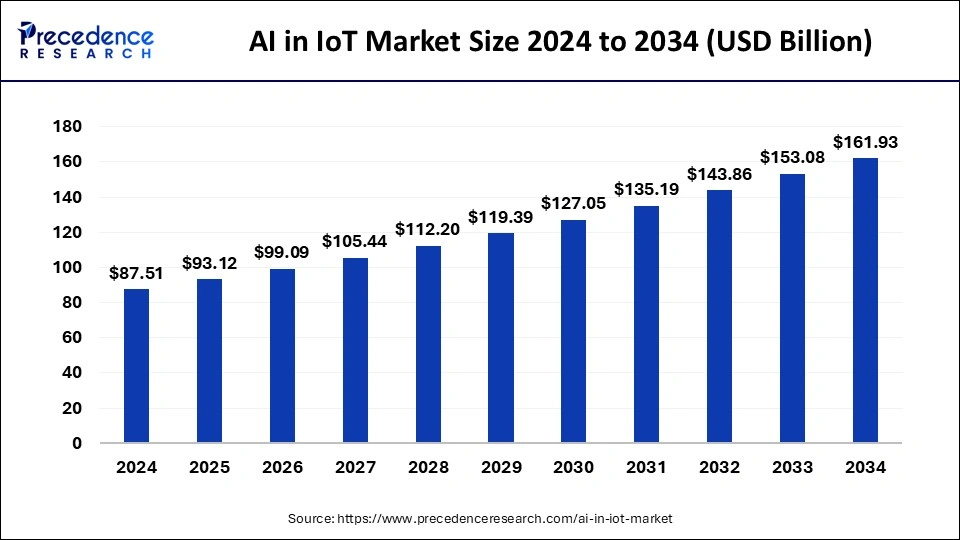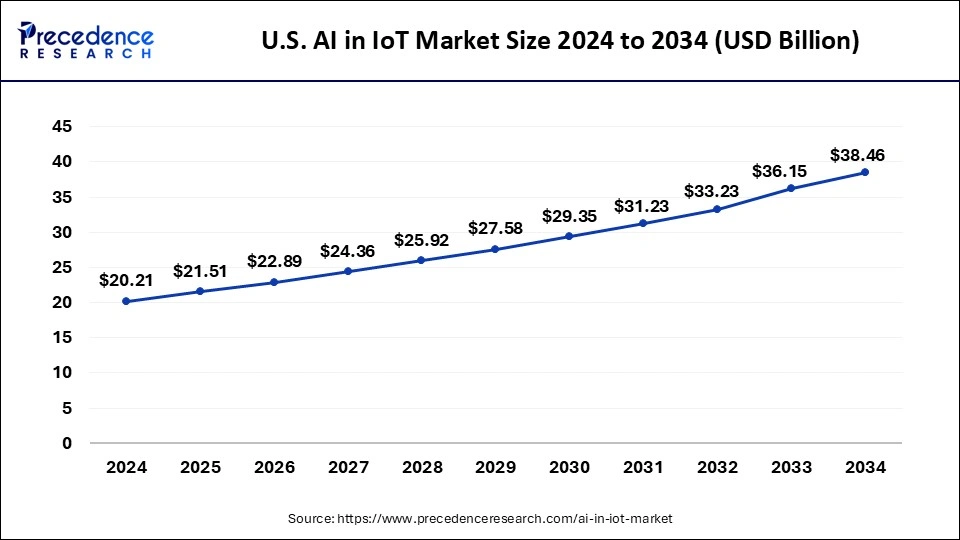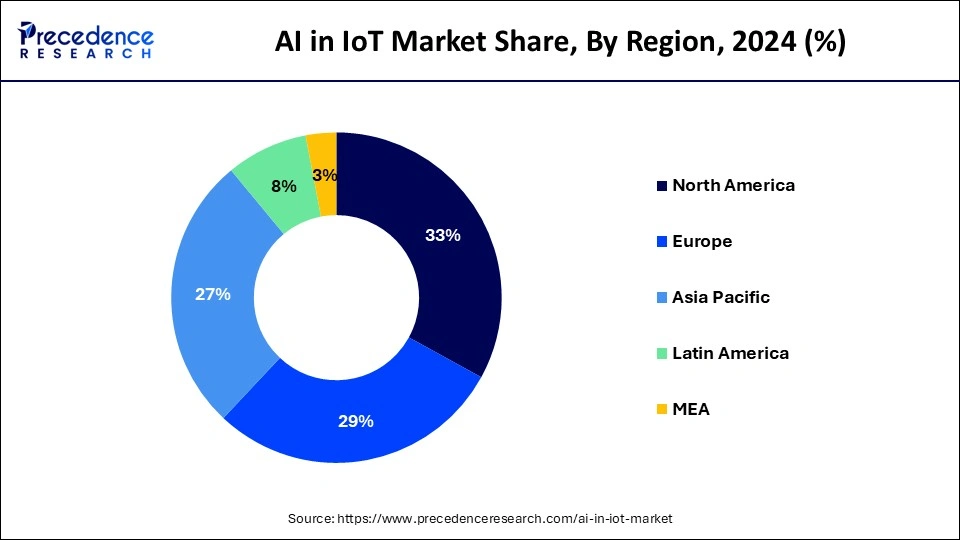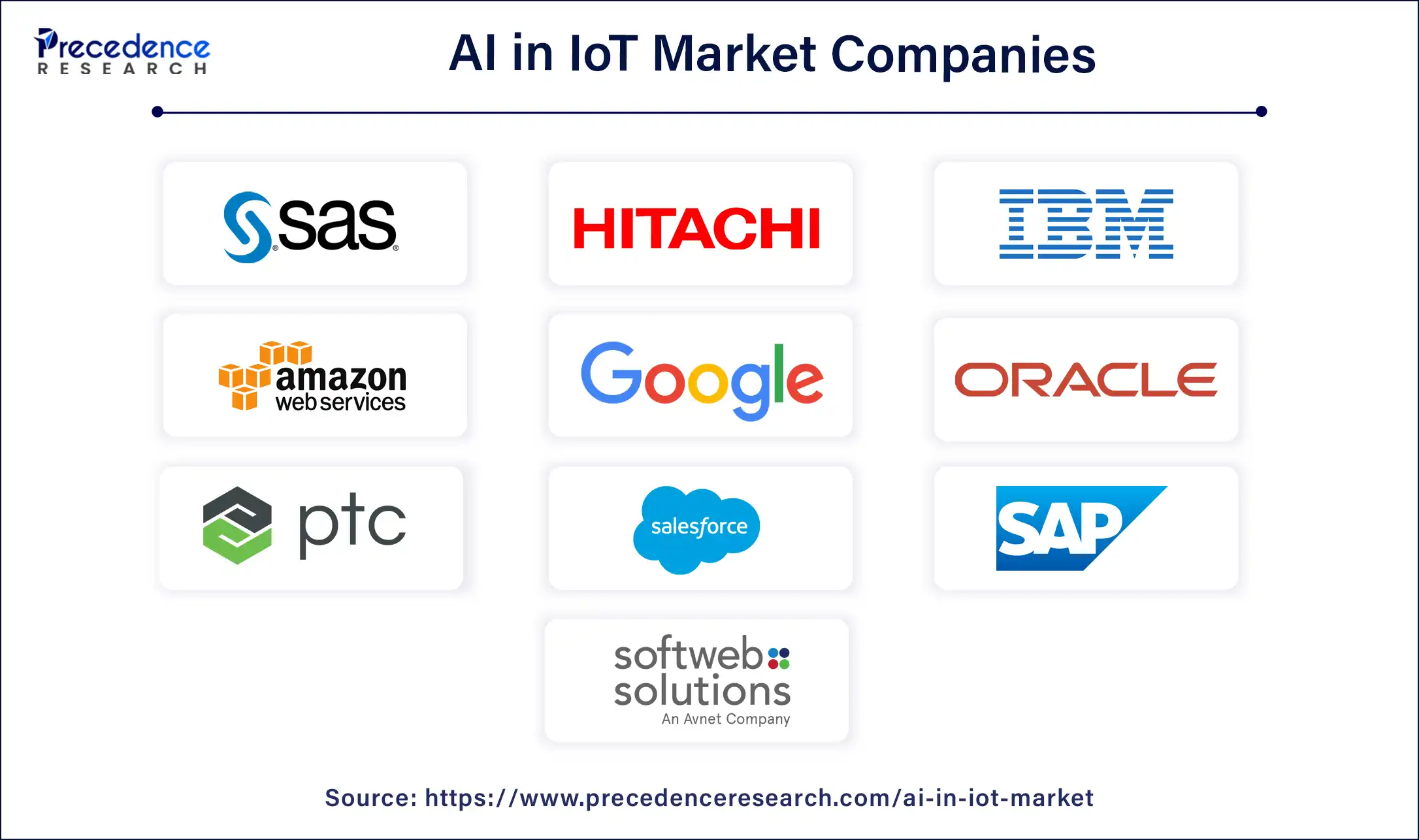The global AI in IoT market size is calculated at USD 93.12 billion in 2025 and is forecasted to reach around USD 161.93 billion by 2034, accelerating at a CAGR of 6.35% from 2025 to 2034. The North America AI in IoT market size surpassed USD 28.88 billion in 2024 and is expanding at a CAGR of 6.38% during the forecast period. The market sizing and forecasts are revenue-based (USD Million/Billion), with 2024 as the base year.
The global AI in IoT market size was estimated at USD 87.51 billion in 2024 and is predicted to increase from USD 93.12 billion in 2025 to approximately USD 161.93 billion by 2034, expanding at a CAGR of 6.35% from 2025 to 2034. Factors such as growth in digitalization and an increase in the adoption of advanced technologies positively impacted the growth of the AI in IoT market.

The U.S. AI in IoT market size was exhibited at USD 20.21 billion in 2024 and is projected to be worth around USD 38.46 billion by 2034, poised to grow at a CAGR of 6.65% from 2025 to 2034.

North America dominated the global AI in IoT market in 2024. The growing investment in advanced technologies, including cloud-based services, AI, machine learning, business analytics solutions, and IoT, aims to enhance business operations and customer experience by driving the growth of the market.
The United States is poised to dominate the AI in IoT market in North America due to substantial investments, AI innovations, and advanced data collection technologies. Increased government spending on IoT and AI, along with the growing presence of AI in IoT vendors, is expected to propel market growth during the forecast period. Furthermore, the demand for 5G-enabled IoT connections is projected to increase.

Asia Pacific is anticipated to witness the fastest growth in the AI in IoT market over the studied period. The increased penetration of digitalization and higher adoption of advanced technology are anticipated to offer significant growth opportunities for the market in this region. Furthermore, as a major contributor to the global economy, China's economic landscape is evolving rapidly due to rising labor costs and the unsustainable traditional migrant worker model. These factors have driven the economy to integrate automation into its industrial processes.
AI has emerged as a powerful technology capable of replicating human intellectual functions. Similarly, IoT refers to a network of interconnected devices with unique IDs that communicate data across a network without human interaction. The integration of AI in IoT systems has enabled businesses to develop sophisticated machines that mimic human behavior and assist in decision-making with minimal human intervention.
The AI in IoT market is growing rapidly due to the increasing fusion of AI technologies with IoT systems. This combination allows smart devices and networks to collect, analyze, and act on vast amounts of data in real-time, improving automation, efficiency, and decision-making capabilities.
| Report Coverage | Details |
| Market Size by 2034 | USD 161.93 Billion |
| Market Size in 2025 | USD 93.12 Billion |
| Growth Rate from 2025 to 2034 | CAGR of 6.35% |
| Largest Market | North America |
| Base Year | 2024 |
| Forecast Period | 2025 to 2034 |
| Segments Covered | Component, End-user, and Regions |
| Regions Covered | North America, Europe, Asia-Pacific, Latin America, and Middle East & Africa |
Rising big data volume
The expansion of mobile traffic, cloud computing, and the adoption of the AI in IoT market has significantly increased the volume and complexity of data and fueled the growth of big data. Big data analytics provide valuable insights and actionable information from large datasets. Organizations can utilize predictive analytics for risk assessment, operations, marketing, and fraud detection. Therefore, data and analytics are becoming indispensable components for enterprises.
Cybersecurity issues
The proliferation of the AI in IoT market products and services expands the network's surface area, increasing the number of potential attack vectors. An IoT could exploit a single connected, unprotected device to launch an active attack on a network. Such attacks on critical infrastructure in industrial settings could result in significant losses and can hinder market growth. Furthermore, the shortage of skilled professionals in AI infrastructure and concerns regarding data privacy and security are anticipated to impede market expansion.
Advancements in edge computing
A significant opportunity in the AI in IoT market is the advancement of edge computing technologies. Edge computing processes data closer to its source, such as IoT devices, minimizing latency, reducing transmission costs, and decreasing reliance on centralized cloud services. By embedding AI capabilities directly into edge devices, real-time data processing and decision-making become faster and more reliable, which enables more autonomous IoT operations.
The software segment dominated the global AI in IoT market in 2024. The segment is further divided into sub-segments: remote monitoring, security, data management, network bandwidth management, real-time streaming analytics, and edge solutions. Among these, data management holds a significant market share. IoT data management is commonly used to predict wear and tear on connected assets and infrastructure. Moreover, Continuous innovation in this software segment ensures its crucial role within the AI in the IoT ecosystem, promising sustained growth and expansion in the coming years.
The platform segment is expected to grow at a significant rate in the AI in IoT market during the projected period. This can be attributed to the technological advancements that enabled AI in IoT platforms, transforming industries worldwide, including BFSI, manufacturing, and healthcare. These platforms facilitate developers in connecting, managing, and integrating data from IoT devices into various applications and services. They also aim to reduce development time and costs for IoT solutions by providing standard components for enterprises to build upon. These factors have contributed to the growth of platforms in AI in IoT market.
The manufacturing segment led the AI in IoT market in 2024. The manufacturing sector has increasingly utilized AI-powered IoT solutions to boost operational efficiency, enhance product quality, and minimize downtime. Companies are integrating AI with IoT to develop ‘smart factories’ where machinery and equipment communicate, predict failures, and self-optimize operations using real-time data. This integration has streamlined production processes by significantly reducing operational costs and contributed to the segment’s major market share.
The banking, financial services, & insurance segment is expected to grow at a significant rate in the AI in IoT market during the forecast period. In the banking, financial services, & insurance (BFSI) sector, IoT-enabled connected banking solutions help banks better serve their customers by utilizing data from various smart devices. This information allows customers to make informed financial decisions. Additionally, banks can offer value-added services, financial assistance, and personalized products using readily available customer data.

By Component
By End-user
By Geography
For inquiries regarding discounts, bulk purchases, or customization requests, please contact us at sales@precedenceresearch.com
No cookie-cutter, only authentic analysis – take the 1st step to become a Precedence Research client